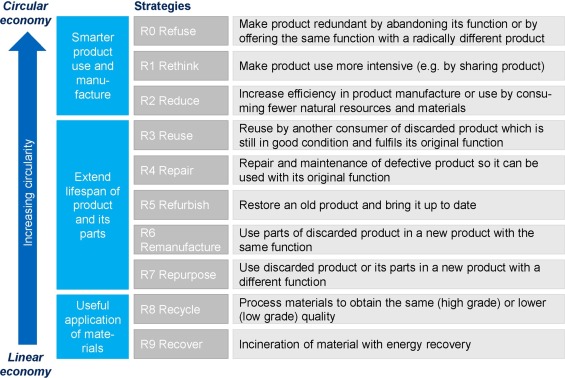Resonance has a number of current projects that align broadly with the conceptualization of a "circular economy." In the last year, we published several articles that address challenges that our clients and sustainability leaders had identified (e.g., "Recycling and the Circular Economy," and "The Growing Emphasis on Measuring Circularity"), as well as current trends (Six Themes Emerge from the GreenBiz Circularity Conference).
Although our work and discussions are increasingly including circularity, there is still so much to learn. Let's start with the basics.
What is a Circular Economy?
Our economy is based on a linear “take-make-waste" model. We take raw materials from the earth, make them into consumables and products, and discard them as waste at the end of their life. This creates a lot of inefficiencies (hello, planned obsolescence!) and generates enormous amounts of waste which is harmful to environmental and human health. Considering our ever-growing global economy and population, this system is creating more and more unmanageable waste while using raw natural resources at an unsustainable rate. Without changing course, plastics will outweigh fish in our oceans by 2050.
Circularity in biological and technical cycles. Source: Ellen MacArthur Foundation
But nature works on a circular model—nothing is wasted, rather waste is regenerated into something new and useful.
A circular economy model seeks to preserve value and minimize waste by designing products and processes to use fewer raw materials/more recycled materials, reduce single-use packaging and products, regenerate the environment through their operations, and/or extend products’ life cycles by being more durable, reusable, repairable, and repurposed or recycled.
The Ellen MacAurthur Foundation has produced a <10-minute introductory video on the Circular Economy that gives a sound background on how Circularity approaches work as well as the positive outcomes and impacts of these models. Supplementing, the organization has also included a number of valued resources, listed at the close of this article.
Expanding on the 3Rs we all know (Reduce, Reuse, Recycle), various circular economy frameworks stress anywhere from 7-11 “R”s, as seen in the figure below:
Adopting a Circular Economy model broadly requires big shifts in the private and public sectors, including the expansion of Extended Producer Responsibility (EPR), Right to Repair, and similar legislation; enhanced corporate sustainability commitments—and action; and significant investment and market-based collaboration to develop circular supply chains, which includes scaling up recycling-related enterprises and reverse logistics services.
Still, there are actions we can take as individuals to contribute to a reduction in waste and supportive environment for circularity to become more mainstreamed and even institutionalized.
4 Solutions for Addressing Household Waste
There are four general areas of waste that individuals can assess and address, contributing to circular solutions. Here are some general tips and actions people can take at the individual or household level:
1.Clothing:
Nearly 85% of clothing in the US ends up as waste—much of which is destined for landfills in lower income countries! Thrift stores are a great way to counter this trend. Take a minute to search your local thrift store options and online markets such as ThredUp. You can also check out companies like Patagonia who are trying to change our culture of clothing waste.
2. Food:
Check out these mobile apps aimed at reducing food waste while at the same time helping you to save money!
3. Electronics:
Electronic waste or e-waste is the fasting growing waste stream. Check out options in your area to responsibly and safely dispose of old electronics, or find out what can be refurbished! Here is one resource for the DC area.
4. Plastics:
Look into your local offerings for expanded recycling services, such as Ridwell and TerraCycle, and reuse models such as DeliverZero.
Resonance is Addressing Circularity, Too!
Resonance has been engaged in partnership and client-focused projects on circularity across sectors and locations. Here are four specific projects across our portfolio that demonstrate the ways in which circular economies are critical in accelerating solutions addressing waste and its impacts.
1. Platform for Accelerating the Circular Economy (PACE):
Resonance serves as a strategy and knowledge partner to the PACE Secretariat, pioneering efforts to demonstrate the circular economy's potential as a critical pathway to achieving the Sustainable Development Goals, with a focus on plastics, electronics, food, textiles, and capital equipment systems. We supported the development of the PACE Circular Economy Action Agenda, which brought together over 100 organizations to prioritize catalyzing actions in alignment with its recommendations to double global circularity every decade. Resonance also chairs the food working group and has consulted on several activities in circular food systems, including CIRF below.
2. Circular Food Systems for Rwanda (CIRF):
We led the PACE community through design incubation and funder engagement for its flagship $5 million project in Rwanda with the IKEA Foundation, WRI Africa, and the African Circular Economy Network (ACEN). The CIRF project will deliver a development fund to support SMEs in utilizing circular business models and strengthen the enabling environment for food systems transformation through policy and stakeholder engagement.
3. Catalyzing Inclusive, Resilient, and Circular Local Economies (CIRCLE) Alliance:
Resonance brokered and manages this new Global Development Alliance (GDA) between USAID, Unilever, Ernst & Young, and Resonance. It is launching in India, Indonesia, Vietnam, and the Philippines. Focused on accelerating adoption and scaling of circular business models in plastics, the CIRCLE Alliance will support: i) the development of SMEs and social enterprises, ii) EPR policy adoption and implementation, iii) women’s empowerment in waste value chains, and iv) scaling and sustaining the alliance itself, within Asia and beyond.
4. BHA PSLAs & Procurement Advising:
Humanitarian crises are increasing in number, complexity, and duration. Humanitarian responses can have unintended impacts on waste streams in already fragile communities and countries. USAID's Bureau for Humanitarian Assistance (BHA) is part of the Joint Initiative for Sustainable Humanitarian Assistance Packaging Waste Management to reduce packaging at the source through procurement and supply chains, identify ways to repurpose and recycle waste that creates livelihood opportunities for local communities, and develop ways to dispose of other waste more safely and accessibly. Under PEPSE, Resonance conducted 2 PSLAs to support BHA’s circularity priorities:
- In Ethiopia and Kenya, we identified local SMEs and initiatives that BHA could support to increase recycling of packaging waste at its sites. While there are still considerable market barriers, BHA could take direct action such as partnering with specific social enterprises and instituting a waste management framework. Further, local enabling environments are increasingly favorable.
- We identified opportunities for sustainable sourcing of life-saving Non-Food Items (NFI) via companies based in the US and Canada, leading to three potential partnership models with traditional and non-traditional vendors. We then facilitated discussions between BHA and The Brickle Group, a US company capable of producing a blanket made of recycled polyester to USG specifications.
Additional Resources on Circularity
This article serves as an introduction to circularity and easy ways individuals can address the waste problem at the household level. Here are some additional resources with tips and solutions to consider:
- Explaining the Circular Economy: Rethinking Progress [Article and Video]
- What is the Circular Economy? [PODCAST]
- Circular Supply Chains [White Paper and Video]


 Source:
Source: 